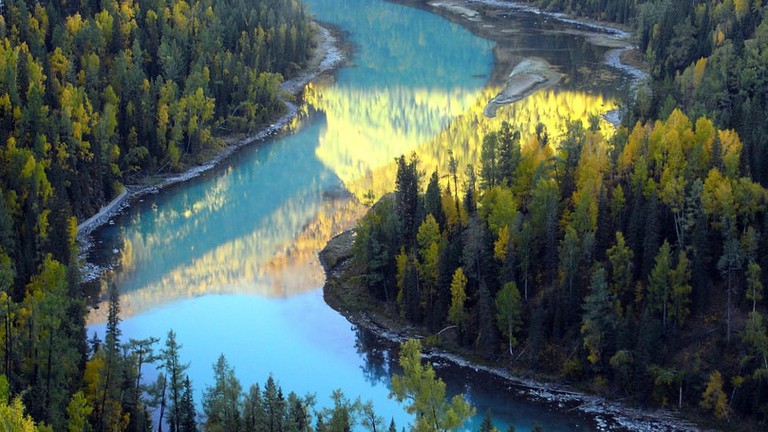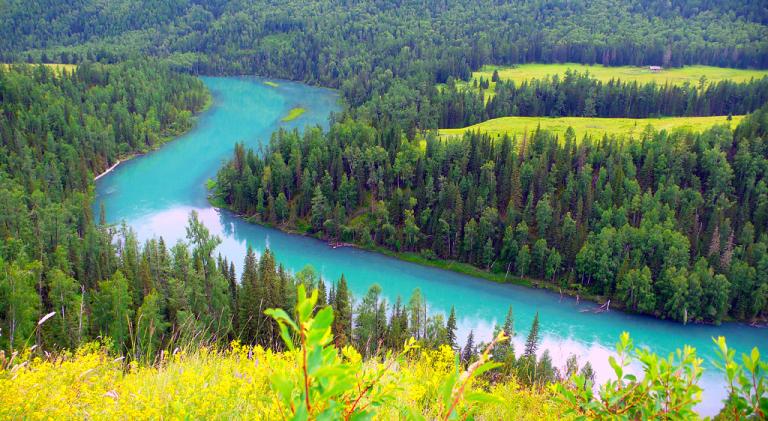Forest resources in xinjiang
7 min readForests are the foundation of the oases ecological system in Xin jiang. Xinjiang is located in the hinterland of the Eurasian continent, surrounded by high mountains and plateaus, which absorbs the moist air blowing from the ocean in northwest, forms abundant rainfall at the steep north slopes and a series of deep canyons, and makes the “wet island”in the vast desert, providing a good environment for the development and distribution of forests and giving birth to a number of unique forest resources.

The total stumpage volume in Xinjiang is 339 milion m³ and the forest stock volume is 301million m3; the woodland area is 2,016,200 hectares, and the shrub land area is 4,627,800 hectares; the forest coverage rate is 4.02%, and the forest coverage rate in oases is 23.5%. Mountain forests are mainly distributed in the Tianshan Mountains and the Altai Mountains,and they are mainly tall trees such as Siberian Larch, Picea schrenkiana, and Needle cypress. The world-famous populus diversifolia and gray poplar are growing in the Tarim and Manas River basins. Haloxylon woods scatter at the edge of Junggar Basin, and rose willows are used for wind prevention and sand fixation around Tarim Basin. Plain forests can be divided into artificial forests, desert natural forests and bottom land forests. The tree species for forest plantation are aspen, elm, Chinese ash, maple, locust, birch, Elaeagnus angustifolia, mulberry trees and various fruit trees.
Xin jiang forest resources can be divided into the following three categories according to topography and location:
Mountain natural forests
Mountain natural forests are important forestry bases in Xinjiang, which mainly distribute in the northern slope of Tianshan Mountains and the Altai Mountains, and a small amount also distributes in the southern slope of Tianshan Mountains, Kunlun Mountains, Baerluke, Beita, and Alataw Mountains.
The tree species in southern and northern slopes of Tianshan Mountains and Kunlun Mountains are mainly the picea schrenkiana pure forest, and Siberian Larch in the Kumul forest of eastern Tianshan.A small amount of poplars and birches distribute at the lower part of the mountain and valley areas. The rainfall at the northwest of the Altai Mountains forest region is abundant with a cold and wet climate; and little precipitation in the southeast with a dry climate; the horizontal distribution of forests becomes narrower from northwest to southeast, and the lower limit is also higher and higher. Species distributedthroughout the Altai Mountains are mainly Siberian Larch, and Picea schrenkiana, mixing in the lower part of the mountain and the terraces on both sides of the valley, and also dominant in some areas. There are also some Betula pendula and poplars in the mixing areas of Siberian Larch, and Picea schrenkiana, and sometimes you can also see small pieces of pure forest of Betula pendula or poplars on both sides of the riverbed.
In the northwest of the Altai Mountains, that is Haba River and Burqin Forest Region; there is also the distribution of Xin jiang Firs and Pinus sibirica, forming the northern Taiga Adventure landscape. The species in Sawuershan are mainly the Siberian Larch, and Picea schrenkiana in Baerluke and Alataw Mountains.
Throughout the mountain forests, there are also many bushes and shrubs of willow, Rosa multiflora, Honeysuckle, Embroidery Chrysanthemum, Cotoneaster, Berberis, and Procumbent Juniper distributed on the sunny and semi-sunny slops, and beside the valleys.
Plain desert and valley natural forests
Plain desert and valley natural forests refer to the natural broadleaf forests on both sides of rivers, and all the trees belong to the poplar class. The arboreal forests mainly distribute on the terraces and flood plains of a few rivers in Tarim Basin, and a few in Junggar Basin, with the main tree species of Populus diversifolia and Populus pruinosa. There are also large areas of desert shrubs in those areas, such as rose willow, Haloxylon, and Halimodendron Halodendron. Valley forests mainly distribute in the shoal zones of li River and Irtysh River system, and the main species are Populus X, Populus Talassica, Bitter poplar, Populus alba, Populus canescens, Populus nigra, Fraxinus sogdiana bunge, and white willow, and so on. There are also some shrubs in this distribution area, such as Rosa Multiflora, Honeysuckle, and Berberis.
Plain artificial forests
Plain artificial forests in Xin jiang mainly distribute in plain agricultural areas, and rare in pasturing areas. They are mainly the agricultural protection forests, and then the economic forests, timber forests, fuel wood forests, and a small amount of special forests.The species are Elaeagnus angustifolia, Acer negundo, Robinia pseudoacacia, Quercus Robur, Coniferous tilia, Ulmus laevis, and Amur Cork Tree. Economic forests mainly include Juglans regia, almond, mulberry and various fruit trees. The agricultural protection forests are mainly formed by arbors with shrubs, arbors are mainly poplar, and then elm and willow; and shrubs are mainly Elaeagnus angustifolia. The forests are mainly the fast-growing and high-yield plantations, scattering in pieces and also in strips with the function of timber forests and protection forests. Fuel wood forests are mainly distributedin barren lands at the edge of the farmland and the flood plains on the west bank with the species of Elaeagnus angustifolia, rose willow, Hippophae rhamnoides, Haloxylon, and Calligonum mongolicum, and so on. Economic forests can be divided into oil-yielding trees, fruit forest, special economic forests and other economic forests. The species of fruit forests are mainly apple, pear, peach, apricot, dates, pomegranates, plum-leaf crab and crabapple etc; the species of special economic forest is Lycium chinense Miller; and the other economic forests are mainly mulberry. Oil-yielding trees and mulberry woods are mainly distributed in Southern Xin jiang, and other economic forests are all over Xinjiang.The special forests are mainly the urban green forests and seed orchards of above the county level, so there are many species, such as Chinese ash, maple, English Elm, Ulmus pumila, Catalpa pine, oriental plane, Robinia pseudoacacia, poplar and willow and so on.

In addition, the shrubs shall also be mentioned when talking about the forest resources in Xinjiang. In Southern Xinjiang the shrubs are mainly formed by tamarix chinensis, while Haloxylon in Northern Xin jiang. They have formed the features of resistance to drought, salinity, barren and hindering wind-drift sands, widely scattered at the edge of alluvial fans, river shoals, and terraces of rivers, around the lakes, in Southern and Northern Xin jiang and fixed or semi-fixed sand dunes, and lowland between the dunes. The shrubs are mainly formed by Tamarix ramosissima and Taklimakan tamarix chinensis in TarimBasin along the Tarim River and Peacock River, and there are also shrubs of Populus diversifolia, Populus pruinosa, and Elaeagnus oxycarpa scattering at the edge of alluvial fans on both sides of the basin in the north and south, and the terraces. The shrubs are relatively concentrated in the middle reaches of Tarim River with pure vigorous tamarix chinensis woods of up to 3~5 m; and in the downstream, the woods are often mixed with Haloxylon and Halimodendron Halodendron, or individually grow on fixed dunes. The desert Haloxylon woods in Junggar Basin are the most widely distributed zonal desert vegetation, even and dense with the height of up to 8 m, which is the typical desert forest in Central Asia.
The rich forest resources and pastures in Xin jiang provide a sound ecological environment for animals and plants to grow, perch and reproduce. In order to better protect all kinds of typical ecosystems, the rare and endangered wildlife resources, and improve the ecological and living environment in Xinjiang, people’s government of Xin jiang Uygur Autonomous Region approved the establishment of Barluk Mountain, Hanas, Tianchi and other natural reserves in 1980. Up to now,35 nature reserves of various types have been established in Xinjiang, with the total area only next to Tibet, ranking second in China.Among them 8 are National Nature Reserves, namely Hanas, Tomor Peak, Western Tianshan, Tarim Poplar, Bayanbulak swan, Ganjia Haloxylon Ammodendron Forest, Lop Nor wild camels, and Altun Mountains. There are 22 autonomous region-level nature reserves and 5 of lower levels. The number of wild camels in the Wild Camel Nature Reserve accounts for more than 1/3 of the total number of wild camels in the world; Przhevalski’s Horse that has been extinct for 100 years has returned; Beaver, Testudo horsfieldi, and Ranodon sibiricus are only found in the wild animal nature reserves in Xinjiang; Amygdalus ledebouriana andFraxinus Sogdiana Bunge can be only found in the wild plant nature reserves in Xinjiang; the wild plant species genes in Wild walnut nature reserve are extremely rare in the world; Tianchi, Tarim populus euphratica forest and Qitai desert grassland nature reserves have joined the International Man and Biosphere Reserve Network; Hanas, Qitai silicified wood-dinosaur fossil national geological park have become the gems on deserts.
Up to now, the area of Natural Reserve has reached 22.1 million hectares in Xinjiang, accounting for 13.27% of the land area of Xinjiang. These natural reserves scatter all over Xinjiang, covering more than 90% of rare wild plants and animal species in Xinjiang, which are the most precious natural heritages left to future generations and also the paradises for wild animals and plants to breed freely.









